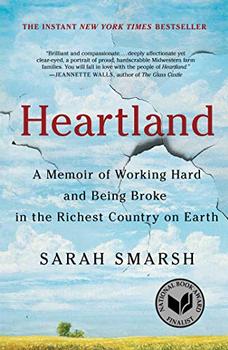Summary | Excerpt | Reading Guide | Reviews | Beyond the Book | Read-Alikes | Genres & Themes | Author Bio

A Memoir of Working Hard and Being Broke in the Richest Country on Earth
by Sarah SmarshThis article relates to Heartland
 Contrary to many deeply guarded beliefs about people living in poverty in the United States, most who can't afford the necessities of life are, in fact, employed. The United Way calls these people Asset Limited, Income Constrained, Employed (ALICE). More than 34.7 million families in the United States (10.6%) fell into this category in 2018, and their numbers are growing. You probably see them every day. They're waitresses, receptionists, salespeople and cashiers. They get by month-to-month and are able to save very little. This is because poverty is expensive.
Contrary to many deeply guarded beliefs about people living in poverty in the United States, most who can't afford the necessities of life are, in fact, employed. The United Way calls these people Asset Limited, Income Constrained, Employed (ALICE). More than 34.7 million families in the United States (10.6%) fell into this category in 2018, and their numbers are growing. You probably see them every day. They're waitresses, receptionists, salespeople and cashiers. They get by month-to-month and are able to save very little. This is because poverty is expensive.
Housing
One of the largest expenses for any budget is housing. Across the U.S., the growing cost of rent has greatly outpaced wages. Approximately 47% of renters spend more than 30% of their income to rent a living space, and a full 24% spend at least half of their income just to rent one. These expenses are compounded by security deposits and fees. When people can't afford to rent, they might end up staying in a residential motel that costs even more than an apartment. Having to allocate this much money to housing burdens families, leaving them less each month to devote to other essentials like food and transportation.
Childcare
For families, childcare can become another extreme expense. In 2014, center-based infant care cost, on average, $402 per month on the low end in Mississippi to $1,422 per month on the high end in Massachusetts. The cost of cutting corners in this area is extremely high. Less expensive childcare options can be difficult to find, and those available may not offer the same level of care and school preparation that more highly trained facilities would. Bargain basement childcare can also pose health and safety risks, and using untrained childcare providers can lead to learning delays.
Health
Health comes into play not just because those living at the subsistence and poverty levels can't afford healthcare. The conditions of living in poverty often contribute to poor health. From living in food deserts (areas where good quality food is expensive and scarce) to the high price of many fresh foods, food insecurity is a significant factor that can contribute to many illnesses. Other non-health factors, such as living in dilapidated spaces or not having enough money for heating in the winter, account for up to 50 percent of all poor health outcomes reported in the United States. Once people develop conditions that need treatment, that can cost even more. While those living in poverty may have the option to receive subsidized healthcare, those living under ALICE criteria may be underinsured and forced to pay exorbitant out of pocket costs.
With so many things against them, it is easy for ALICE individuals to end up slipping through the cracks.
All facts and stats taken from a United Way ALICE Report.
Filed under Society and Politics
![]() This "beyond the book article" relates to Heartland. It originally ran in September 2018 and has been updated for the
September 2019 paperback edition.
Go to magazine.
This "beyond the book article" relates to Heartland. It originally ran in September 2018 and has been updated for the
September 2019 paperback edition.
Go to magazine.
If there is anything more dangerous to the life of the mind than having no independent commitment to ideas...
Click Here to find out who said this, as well as discovering other famous literary quotes!
Your guide toexceptional books
BookBrowse seeks out and recommends the best in contemporary fiction and nonfiction—books that not only engage and entertain but also deepen our understanding of ourselves and the world around us.